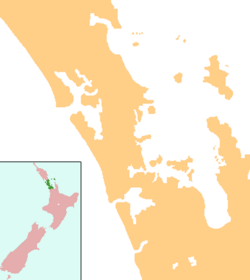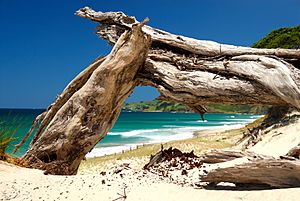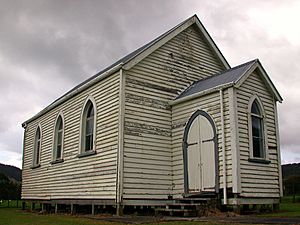Pākiri facts for kids
Quick facts for kids
Pākiri
|
|
|---|---|
| Country | New Zealand |
| Region | Auckland Region |
| District | Auckland Council |
| Community board | Rodney Local Board |
| Subdivision | Wellsford subdivision |
| Area | |
| • Total | 28.52 km2 (11.01 sq mi) |
| Population
(2018 Census)
|
171 |
Pākiri is a locality in Auckland, in the former Rodney District of New Zealand. Leigh is about 9 kilometres (6 mi) to the south-east. The Pākiri River flows through the area and into the Hauraki Gulf / Tīkapa Moana to the north-east.
The area is named for the Ngāti Wai chief, Te Kiri. The beach was originally known by the name Ngā One Haea o Pākiri ("The Gleaming White Sands of Pakiri"), Pākiri being the name of the Ngāti Wai pā found at the headlands of the Pākiri River. Ngāti Manuhiri, an iwi descended from the early Ngāti Wai ancestors in the area, are the mana whenua for the Pākiri area.
Pākiri Beach is a 14-kilometre-long (8.7 mi) white sandy beach to the north. It is a tourist destination known for its natural environment. The Auckland Regional Council purchased two blocks of land in 2005, totalling 178 hectares (440 acres), with three kilometres (2 mi) of beach frontage, and is developed this into the Pākiri Regional Park.
During the 1860s, Pākiri Beach was the location of a kauri sawmill at the mouth of the Pākiri River.
Suction dredging has been used to mine sand from the sea floor off the coast since the 1950s. This caused controversy in 1994, when 170,000 cubic metres (222,000 cu yd) of sand was to be extracted to bolster the popular Mission Bay in Auckland, and was brought to the Planning Tribunal in the case Haddon v Auckland Regional Council for violation of the Resource Management Act 1991, and its provisions for kaitiakitanga.
Demographics
Pākiri is in an SA1 statistical area which covers 28.51 km2 (11.01 sq mi) and includes Pākiri Beach. The SA1 area is part of the larger Cape Rodney statistical area.
| Historical population | ||
|---|---|---|
| Year | Pop. | ±% p.a. |
| 2006 | 147 | — |
| 2013 | 141 | −0.59% |
| 2018 | 171 | +3.93% |
The SA1 statistical area had a population of 171 at the 2018 New Zealand census, an increase of 30 people (21.3%) since the 2013 census, and an increase of 24 people (16.3%) since the 2006 census. There were 57 households, comprising 87 males and 81 females, giving a sex ratio of 1.07 males per female. The median age was 45.4 years (compared with 37.4 years nationally), with 30 people (17.5%) aged under 15 years, 24 (14.0%) aged 15 to 29, 81 (47.4%) aged 30 to 64, and 33 (19.3%) aged 65 or older.
Ethnicities were 82.5% European/Pākehā, 35.1% Māori, 5.3% Pasifika, and 1.8% other ethnicities. People may identify with more than one ethnicity.
Although some people chose not to answer the census's question about religious affiliation, 50.9% had no religion, 26.3% were Christian, and 17.5% had Māori religious beliefs.
Of those at least 15 years old, 27 (19.1%) people had a bachelor's or higher degree, and 24 (17.0%) people had no formal qualifications. The median income was $28,800, compared with $31,800 nationally. 15 people (10.6%) earned over $70,000 compared to 17.2% nationally. The employment status of those at least 15 was that 57 (40.4%) people were employed full-time, 39 (27.7%) were part-time, and 3 (2.1%) were unemployed.
Education
Pakiri School is a coeducational full primary school (years 1-8) with a roll of 16 students as of February 2024. Most children are of Māori descent and are affiliated to Ngati Wai and Ngati Manuhiri. The school celebrated its 125th jubilee in 2002.




